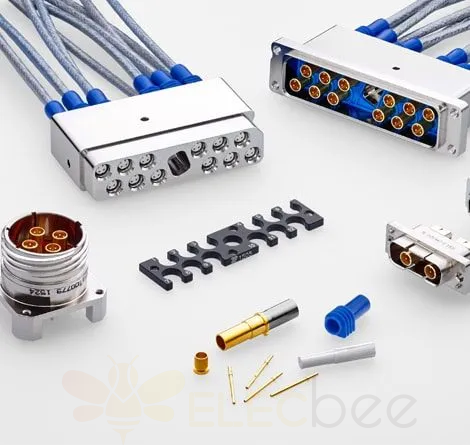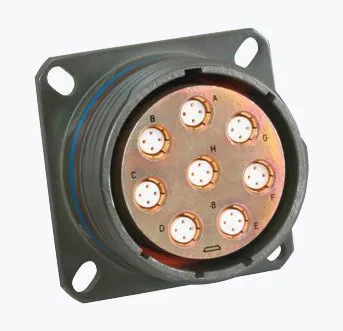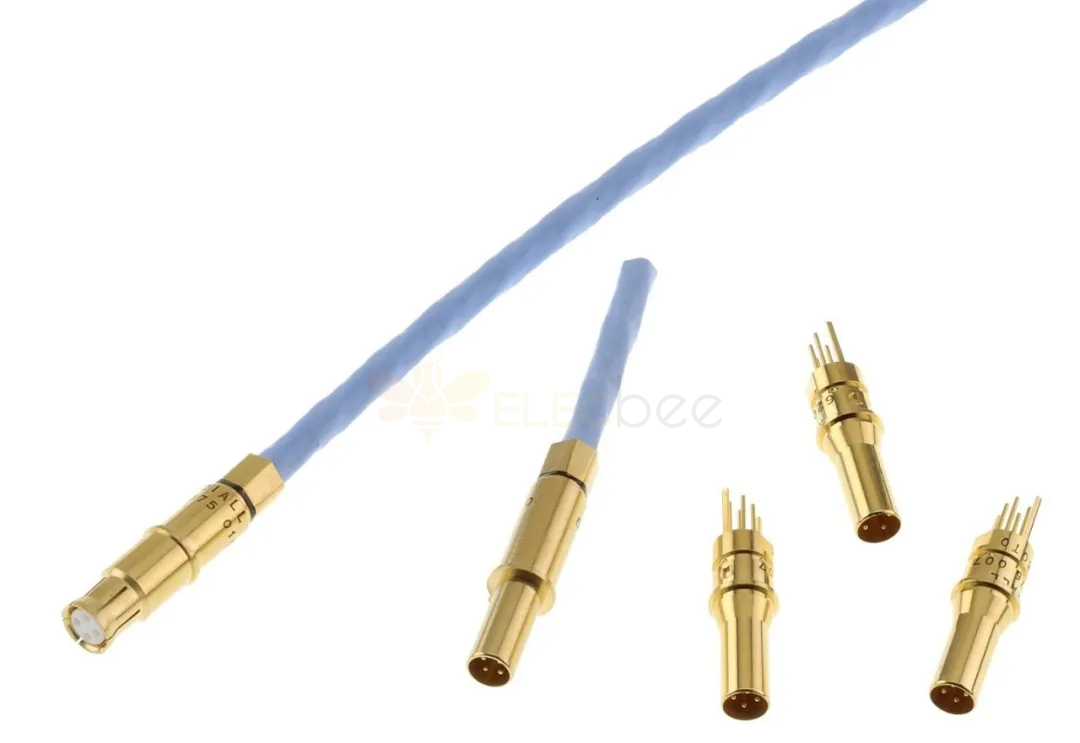Quadrax connectors evolved from the broader category of coaxial and triaxial connector technologies designed to improve signal transmission and reduce interference in high-speed data applications. Companies including Amphenol and TE Connectivity have been instrumental in refining and commercializing quad coaxial designs to meet the aerospace and military's need for rugged high frequency connectors. These companies contributed to the development of the quad configuration, which allowed differential signal pairs to be transmitted with low crosstalk, thus laying the foundation for the quad connectors we see today.

Elecbee's Quadrax Multi-Signal Contact System
Design Notes
Standardization
Multiple standards include quad coaxial connector variants, including:
MIL-DTL-38999: The Military Standard for Circular Connectors includes specifications for quad coaxial contacts to ensure that quad coaxial connectors used in these systems meet stringent requirements for durability, environmental sealing and electromagnetic compatibility (EMC).
ARINC 600 and ARINC 404: These aerospace standards outline the requirements for quad-coaxial connectors used in avionics equipment, particularly for high-speed data transmission in commercial aircraft.

IEEE 802.3: In applications such as Ethernet, IEEE standards apply to the electrical characteristics of the differential pairs within a quad coaxial connector to ensure compliance with data protocols such as 1000BASE-T (Gigabit Ethernet).
D38999 Connector with Quad Coaxial, Differential Duplex Contacts from Amphenol Aerospace
Mounting type or type: panel mount, cable mount, or PCB mount
Number of mating cycles: Minimum of 500 and up to 1,500 mating cycles
Location: Quadrax connectors typically have four conductors in a single contact arranged in a four-channel configuration (two pairs) for differential signals such as Ethernet or high-speed data lines. In circular connectors, such as those based on MIL-DTL-38999, the quad coaxial contacts can be placed in multi-position housings, allowing multiple quad coaxial contacts to be used in a single connector housing.
Pins: Quadrax connectors typically have four pins within each Quadrax contact, arranged in a square or diamond pattern. These four pins consist of two differential pairs (two positive and two negative pins) designed to transmit high-speed data signals with minimal crosstalk.
In circular connectors, such as those following the MIL-DTL-38999 standard, multiple quad coaxial contacts can be mounted in a single housing, allowing multiple quad coaxial connections within a single connector body.
Pitch: Typically, the pins within each quad coaxial contact are spaced very closely together, usually about 1.27 mm (0.05 in.) center-to-center.
Height: The height of each individual pin within a contact is typically about 3.5 mm to 5 mm (0.14 to 0.20 in.), but may vary depending on contact type and connector size.
Contact resistance: Quad coaxial connectors should have a contact resistance of less than 5 milliohms (mΩ) per contact.
Termination: Crimp, solder, or IDC
Material Specifications: Reinforced materials help ensure the performance, reliability, and longevity of quad coaxial connectors, especially in harsh environments such as aerospace, military, and high-speed data applications. Shells are typically made of thermoplastic or thermoset polymers such as polyamide (nylon) or PBT (polybutylene terephthalate) for general applications.
For harsh or high-performance environments, housings can be made of aluminum (often with coatings such as chromate or anodized aluminum) or stainless steel for enhanced durability and environmental resistance.
Physical Properties
Insulation: The insulation around the contacts is usually made of polyethylene or PTFE (Teflon), which have low dielectric constants and good electrical insulation properties. This ensures minimal signal loss and high-speed data integrity.
Shielding: Electromagnetic shielding is used to prevent EMI (electromagnetic interference). This shielding is usually made of tinned copper, aluminum or stainless steel.
Latching Mechanisms: Bayonet, threaded, push-pull, latching or clip-on latching mechanisms are available to ensure secure connections under demanding conditions.
Environmental Characteristics
IP Rating/Sealing Mechanism: Quadrax connectors for outdoor or harsh environments are rated IP67 or IP68.
Reinforcement: Depending on the requirements of the application, a variety of reinforcement features can be specified with Quadrax connectors. Sealing, corrosion resistance, chemical resistance, EMI, shielding, UV protection as well as vibration, shock and impact resistance are additional reinforcement layers that may be applicable.
Temperature Range: Quadrax connectors can operate over a wide temperature range of -55 °C to +125 °C (-67 °F to +257 °F), depending on the specific connector and material used.
Electrical Characteristics
Voltage AC/DC:
For military-grade or high-performance quad coaxial connectors, voltage ratings are typically around 250-500 V (volts) AC or DC, but this can vary by manufacturer and specific application.
For low voltage, high speed data transmission applications (e.g., Ethernet), the voltage rating may be lower, usually about 50-150 V.
Current (Amps): Most quad coaxial connectors are typically rated from 3 A to 10 A per contact Some quad coaxial connectors are designed for high current applications and can carry up to 20 A or more per contact, especially connectors used for power transmission or industrial applications.

Markets and Applications
Military and Aerospace, Transportation, Industrial, Automotive, Datacom and Telecom, Medical, Test and Measurement
Quadrax connectors are commonly used in military and avionics systems; in radar, sonar, and other sensor systems; satellite communications and space exploration; in telecom equipment; energy and power generation; medical imaging, robotics, and wearables, and many more applications.

